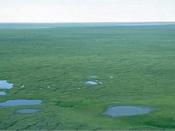The Alaska National Interest Lands Conservation Act of 1980 established the 19 million-acres of what is now called the Artic National Wildlife Refuge (ANWR) (fig. 3). In this original act, Congress decided to hold off on making a decision on how to manage the one and a half million-acre coastal plain due to the area's potentially enormous oil and gas resources and its importance as a wildlife habitat. In 1987, the Department of the Interior submitted a report to congress on the potential oil and gas deposits that may be located in ANWR. Since then, several oil wells have been drilled and oil fields discovered near ANWR. New geologic and geophysical data have become available, seismic processing and interpretation capabilities have improved. Oil exploration in ANWR is a very heated topic among many public officials. The essence of the conflict is twofold: the possibility that the Artic Refuge contains one of the best remaining prospects for significant oil discovery in the United States, and that the Refuge contains some of the last true remaining wilderness in the country.
The question is will the potential oil and gas resources gained by the drilling out weight the environmental damage that will be created?
The economic impact of the ANWR oil and gas reserves could have a substantial affect on domestic oil prices paid by consumers. We are currently paying inflated prices for oil (Fig. 1). However, many environmentalists and Democrats do not see the potential of ANWR. Since oil is a nonrenewable resource there is no way of producing more. There are better ways of limiting the reliance on foreign oil imports and creating a stable long-term energy plan. One such way is improving the fuel efficiency of motor vehicles. Holding relatively constant the production of automobiles,


